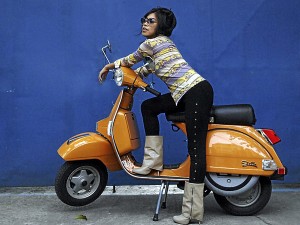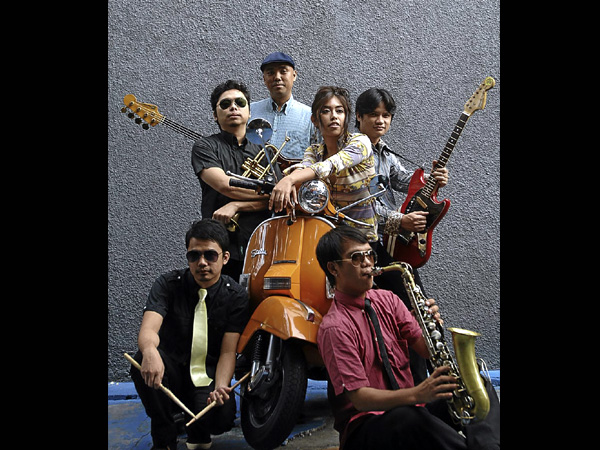
People who ride scooters and those who appreciate soul music are after the same thing: the grit, the groove and that dirty, greasy sound that tells you this is the real deal
Big bikes may rock, but vintage scooters have soul.
How else explain the cult of the Vespa?
Conceived in the aftermath of World War II as a quick-and-dirty way of getting war-torn Italy back on its feet, the Vespa was meant to be a cheap, mass-produced utility vehicle.
But the Italians, it seems, are incapable of doing anything without flair, and the Vespa – with its curvy, feminine silhouette and elegant simplicity – soon became an icon of Italian style.
With a little savvy marketing, the little scooter soon captured popular imagination. When Gregory Peck swept Audrey Hepburn off her feet on a Vespa in “Roman Holiday” – well, that was the moment.
Macho types still preferred Harley Davidsons and Triumphs, and the Honda Cub eventually usurped its place as a cheap utility ride, but the Vespa (and for a while, its rival the Lambretta) was it for those with a certain stylish sensibility.

In the ’60s, the emerging Mod (short for “modern”) youth subculture in England embraced the Vespa along with all things Italianate in an explosion of style. An early example of the globalization of pop culture, the Mods cherry-picked cool wherever they could find it, combining continental fashion with the funk and groove of Black American music. Mod was all about sharp suits and scoots, and dancing all night to rhythm and blues singles from the Motown and Stax labels.
Henceforth, scooters and soul music would forever be associated.
Like all style revolutions, Mod was short-lived, but many of its adherents held on to their scooters and their love for soul music, even if they were now too fat for their slim-cut suits. Dressed down, they devolved into “scooter boys” – though most were now well into middle-age – spending all their disposable income and spare time on primping their scoots with custom paint, chrome and engine modifications. Several times a year, they came together in massive scooter rallies, and relived their glory days by dancing all night to – what else? – soul music.
Several generations later, scooter culture persists, and soul is still its predominant soundtrack. But times have changed, and the classic two-stroke Vespa could no longer keep up with tightening European emission standards. The last “classic” Vespa, the PX series, rolled off the Piaggio production line in 2007.
All subsequent Vespa models are now “modern”: they still have the same sleek signature styling, but they now feature fuel injection, four-stroke engines and automatic transmissions.

Vespa has also long since left behind its original design brief as a cheap, utility vehicle. They’re still eminently user-friendly, and they’re still cheap – compared with Harley Davidsons and BMWs. But today, the latest-model Japanese scooters from Honda, Yamaha and Suzuki typically retail for P60,000 to P90,000, and Chinese scooters can be had for half those prices. The cheapest modern Vespa costs well over P200,000. Blame it on the strength of the Euro and high European labor costs.
Vintage enthusiasts still swear by the Vespa PX, however. They love even its quirks, the way the side-mounted engine skews its weight a bit to the right, the cloud of blue two-stroke smoke that trails in its wake, the clunky manual gear shifting, the engine vibration that could shake tooth fillings loose.
Occasionally, Piaggio caters to this niche market by reissuing the PX in limited runs. But at today’s costs, a brand new, limited-edition PX 150 will retail for something like P280,000. Ouch!
What’s a neo-Mod to do?
Enter the Stella.
Sometime in the ’70s, Piaggio, the company that manufactures the Vespa, outsourced production of the PX series to the LML company in India. When the license ran out, LML continued to manufacture scooters under their own name.
For all intents and purposes, the LML Star is a clone of the Vespa PX, with a few minor differences, and one major one: price. The so-called “Indian Vespas” were half the price of the original Italians.
In the US, LML scooters were marketed by the Genuine Scooter Co. as the Stella. In the last few years, soaring fuel costs have sparked a new wave of interest in scooters even in car-crazy America. (Just check out Tom Hanks’ new movie, “Larry Crowne.”) To meet this demand, LML came up with a stroke of genius—a four-stroke Stella. The Stella 4T combines the best of both worlds: the authentic vintage style of the Vespa PX with a modern 4-stroke engine that complies with current emission standards.
In the Philippines, the LML Star was marketed as the “Vitto,” and is best known as the Yellow Cab Pizza delivery scooter. “Owner” Vittos make up a large number of the local Vespa cultists, represented by groups such as Euroscoot and the Vespa Club of the Philippines.
Expect their ranks to swell even more, because the Stella 4T is now available locally, distributed by 2211 Works, a company which also sells Vespas and Piaggio scooters.
“The Stella improves on all the weaknesses of the PX,” says Nani Juarez, 2211’s general manager and Vespa troubleshooter extraordinaire. “Apart from the 150 cc four-stroke engine that is cleaner and surprisingly has more torque than the PX engine, they improved the engine suspension so there’s less vibration. The Stella has a higher top speed while being more fuel efficient. You also get a modern front disc brake. But it still retains the all-steel body and the classic shape of the Vespa PX series. It’s really the best of both worlds.”
He added that the Stella 4T will be available in 10 colors, with a suggested retail price of P180,000, a substantial discount for cash purchases, and a financing plan in conjunction with RCBC Savings Bank’s scooter financing package.
Apparently, units have been flying off the shelves from word-of-mouth alone, and the first 4T Stellas should be on the road within the next few weeks. In the meantime, local Vespa cultists have another excuse to party, and who better to provide the soundtrack than the Heavy Heavies?
The Heavy Heavies is a soul, funk and R & B band that rose from the ashes of Juan Pablo Dream, the unofficial house band of the local scooter boy scene until it disbanded earlier this year. But where JPD was strictly Mod-inspired ’60s soul and R & B, the Heavies venture into a funkier, heavier groove, combining covers with a handful of original tunes.
“We want to keep the JPD spirit, but with more grit,” says livewire lead vocalist Bianca Holganza. Guitarist Aurelio Castro III, bassist Alexander Dumlao, saxophonist Kim Ventusa and drummer Aldwin Fernando were also in JPD. The only “new” member is trumpet Bong Termulo, late of the Brownbeat All-Stars, which, along with JPD, was another descendant of the Put3Ska family tree.
“The way I see the parallels between scooter culture and soul music is, people who ride scooters and people who appreciate this kind of music are after the same thing: the grit, the groove, that dirty, greasy sound that tells you: this is the real deal,” she adds. “Yung dumi ng kalye at ang dumi ng tunog, doon sya sumasalubong [This is where dirty streets and gritty music meet].”
Photographs by Jim Guiao Punzalan












































